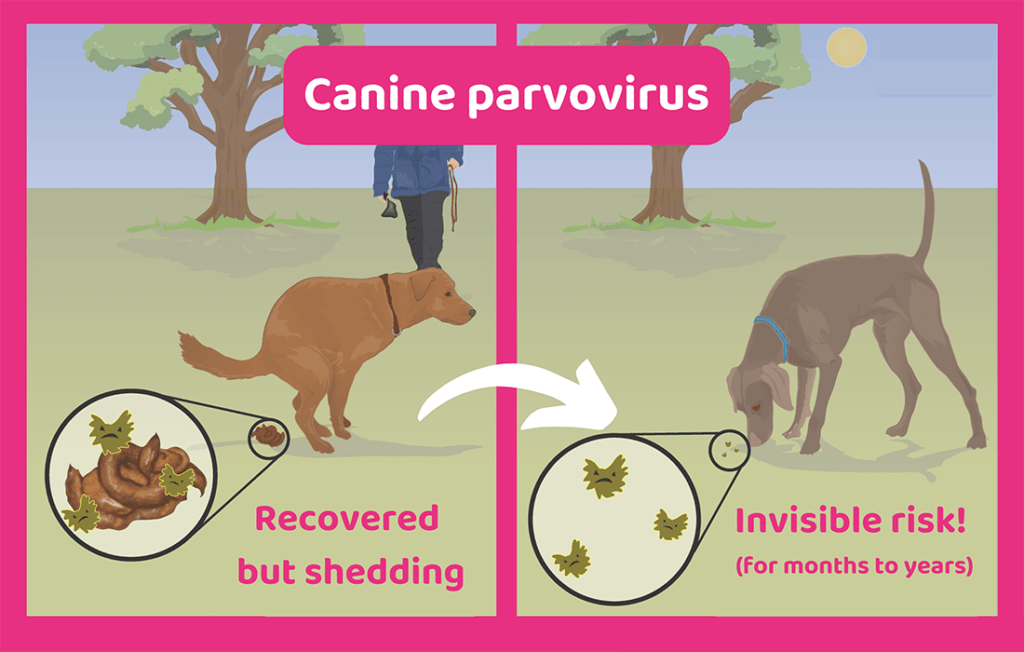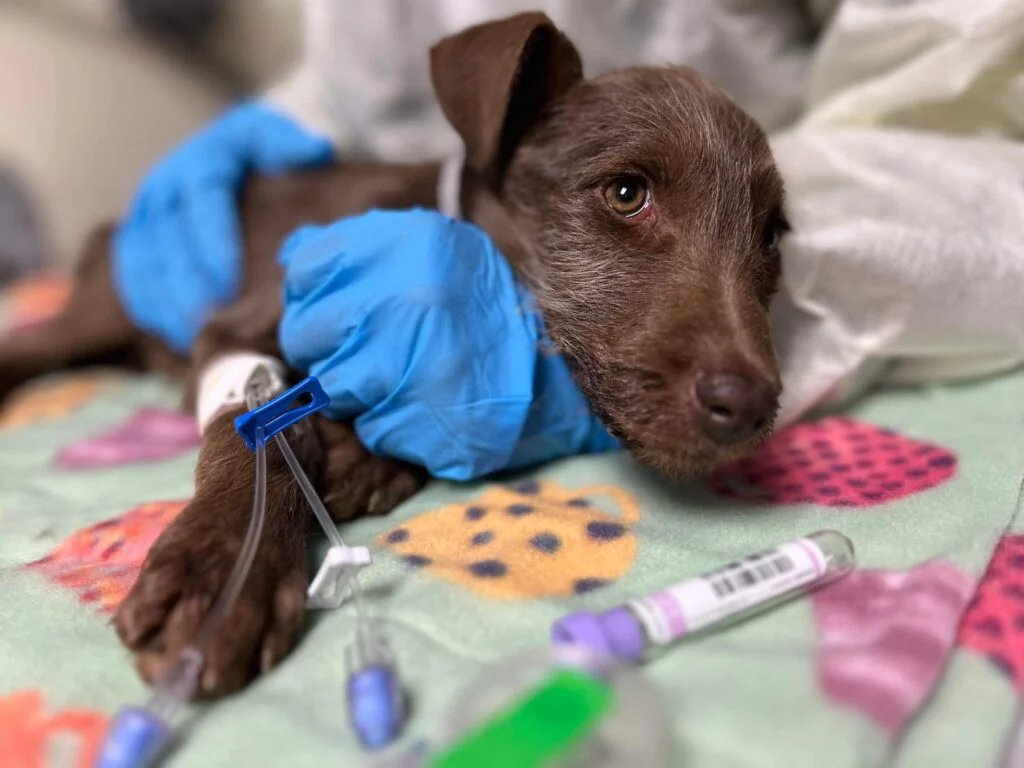Overview

What is parvovirus?
Parvovirus (also known as parvo, canine parvovirus, or CPV) is a virus that causes severe illness and death in dogs. It damages the lining of the intestines, causing severe vomiting and diarrhea. It also attacks infection-fighting cells inside the bone marrow, which weakens the immune system making it very difficult for dogs to recover. Parvovirus is especially serious in unvaccinated dogs and puppies less than six months old because their immune systems aren’t as well developed and so are less able to fight the virus.

How do dogs get parvo?
Most dogs catch parvovirus while they are out exploring. It’s shed in the poo of infected dogs three to four days after they are infected, then for a couple of weeks after their symptoms clear up. Unfortunately, it can then survive in the environment for months to years – meaning it can be found almost anywhere that dogs go, such as gardens, parks, and fields. It can also travel in dirt, so can be found on the bottom of shoes, inside houses, on dog leads, collars, bowls, clothes, toys, and even on human hands.
Most dogs are exposed to parvovirus at some point in their life, so the only way to protect them is through regular vaccination.

Symptoms of parvo in dogs?
Symptoms of parvovirus usually take three to seven days to appear and include:
Diagnosing parvovirus in dogs?
Testing for parvo isn’t always necessary because the symptoms are usually very obvious. However, if needed, it can be diagnosed using a quick poo test that gives a result in approximately 15 minutes. This test is usually very accurate, but if the result isn’t what your vet expected, they may want to check it by sending some poo away to a lab.
Your vet might also run blood tests to check levels of infection-fighting cells and to test for anemia from blood loss.
What are the treatment options?
There is no cure, so dogs with parvovirus need very intensive care and medications to control their symptoms while their body tries to fight the infection. Treatment usually includes:
Caring for a dog recovering from parvovirus?
If your dog has recovered enough to return home, you will need to continue nursing them while they fully recover:
Will my dog survive parvo?
Your dog’s chance of surviving parvovirus is much higher if you take them to the vet as soon as you notice symptoms. Dogs that receive prompt intensive care whilst hospitalized in a veterinary practice are much more likely to survive but, unfortunately, due to the seriousness of parvovirus, some die even with treatment. Parvovirus is nearly always fatal without treatment. Puppies are more at risk of dying, especially those less than two weeks old.
When to contact your vet?
Contact your vet immediately if your dog is showing symptoms of parvovirus. Let them know you think it might be parvo, and wait outside the clinic until your dog is called in to prevent spreading it to other dogs in the waiting room.
There is no need to contact your vet if your dog has simply come into contact with parvovirus, just monitor them closely for symptoms and call your vet for advice if you’re concerned.
Preventing parvovirus?
Vaccinations – the best and only way to prevent parvovirus infection is by vaccinating your dog regularly. They will need two to three parvovirus vaccines while they are a puppy, then boosters regularly throughout the rest of their life.
Buy/rehome responsibly – always buy from a responsible breeder or a reputable rehoming center. Make sure you see your puppy and their siblings with their mum, in the place they are raised, on more than one occasion. All puppies should be healthy and bright with no signs of illness, and their mum should be up to date with her vaccines.
Taking a new puppy out – unvaccinated puppies and puppies that have only had their first injection are at risk of catching parvovirus. Your puppy will be safe to go out for a walk and meet other dogs one to two weeks after they complete their first vaccination course, so until then follow the advice below:
The cost of treating parvovirus?
Parvovirus can cost hundreds, if not thousands of dirhams to treat because most dogs require several days of intensive treatment in a veterinary hospital. It’s important to speak openly to your vet about your finances, the cost of treatment, as well as what you think is right for your dog.
How long should I wait to get a puppy after losing a dog to parvovirus?
If you’ve recently lost a dog to parvovirus, the virus will survive in your home and garden for a long time afterward. It can remain in the environment for months to years and it’s almost impossible to ensure you’ve got rid of it all, especially in areas that are difficult to disinfect such as the garden. This means that any unvaccinated dogs/puppies that come to your home are at risk of catching parvovirus.
If you are considering getting a new puppy, we advise you to wait until they are fully vaccinated before bringing them home (you’ll need to make sure they are properly socialized by the breeder/rescue center). If this isn’t an option, you can reduce the risk of them catching parvovirus by thoroughly disinfecting your home and keeping them out of your garden until they are fully vaccinated – speak to your vet for more advice and read below how to disinfect parvovirus.
How to disinfect after parvovirus?
It’s important to fully disinfect any areas that have been contaminated with parvovirus.
Bleach can kill parvovirus when it is used properly. It is readily available and is relatively inexpensive, but has some drawbacks. It can discolor or even ruin surfaces. The fumes can be irritating to the nose, eyes, and skin.
To kill canine parvovirus on hard non-porous surfaces, prepare a solution of bleach with water. Pre-wash the areas and then mop or wipe with the disinfecting solution. Let stand for ten minutes, then rinse thoroughly and air dry. One treatment should kill the virus as long as you use the proper dilution and allow ten minutes of contact time. For this situation, we would also use a newly purchased bottle of bleach to be sure the bleach active is at label strength. Do not use a bottle of bleach that has been sitting around for too long, since over time the bleach naturally breaks down into salt and water.
Get answers to parvovirus common questions.

| Cookie | Duration | Description |
|---|---|---|
| cookielawinfo-checkbox-analytics | 11 months | This cookie is set by GDPR Cookie Consent plugin. The cookie is used to store the user consent for the cookies in the category "Analytics". |
| cookielawinfo-checkbox-functional | 11 months | The cookie is set by GDPR cookie consent to record the user consent for the cookies in the category "Functional". |
| cookielawinfo-checkbox-necessary | 11 months | This cookie is set by GDPR Cookie Consent plugin. The cookies is used to store the user consent for the cookies in the category "Necessary". |
| cookielawinfo-checkbox-others | 11 months | This cookie is set by GDPR Cookie Consent plugin. The cookie is used to store the user consent for the cookies in the category "Other. |
| cookielawinfo-checkbox-performance | 11 months | This cookie is set by GDPR Cookie Consent plugin. The cookie is used to store the user consent for the cookies in the category "Performance". |
| viewed_cookie_policy | 11 months | The cookie is set by the GDPR Cookie Consent plugin and is used to store whether or not user has consented to the use of cookies. It does not store any personal data. |
Create an account or sign in to save pets you love.
Don't have an account? Contact us
Before you proceed with your adoption application, please review and accept our data handling practices:
Note: By clicking "I Agree & Continue", you will be redirected to an external application form. This tracking system logs your interest but does not capture data from the external form.